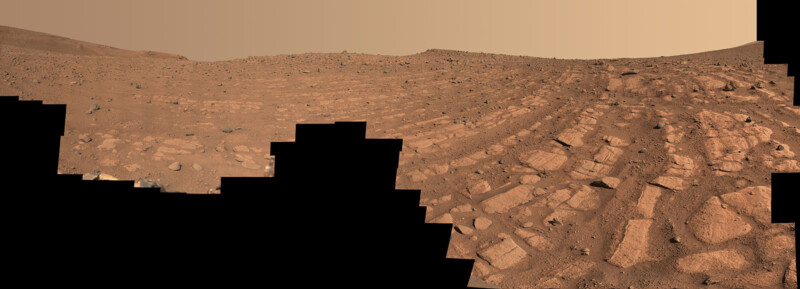NASA Perseverance Rover Captures 152-image Mosaic of Belva Crater
![]()
NASA’s Perseverance Mars rover recently captured a series of 152 images while investigating the Belva Crater which NASA has stitched into a dramatic and striking mosaic.
The Belva Crater is a large impact crater within the much larger Jezero Crater. The Belva Crater interests scientists because it delivers a view of vertical cuts of rocks and sediment on Mars.
“Mars rover missions usually end up exploring bedrock in small, flat exposures in the immediate workspace of the rover. That’s why our science team was so keen to image and study Belva. Impact craters can offer grand views and vertical cuts that provide important clues to the origin of these rocks with a perspective and at a scale that we don’t usually experience,” explains Katie Stack Morgan, deputy project scientist of Perseverance at NASA’s Jet Propulsion Laboratory in California.

NASA compares the vertical cut offered by Belva Crater to highway “roadcuts” on Earth. Geology students often look at areas where construction crews have sliced vertically through rock to build roads, as these cuts allow a view of rock layers and other geological features that can’t be viewed from the surface. Belva Crater offers a similar view of Mars.
Zooming in on Belva Crater. Places like this, where nature has done the excavating for you, can be great for getting a look at exposed rocks from under the surface. Hooray for meteorites! ☄️
See what clues I’m picking up on here: https://t.co/YiNhInhTcd https://t.co/Yi5vPOjUAA pic.twitter.com/9A1b37928z
— NASA's Perseverance Mars Rover (@NASAPersevere) May 18, 2023
Perseverance, which landed on Mars in early 2021, has been actively investigating Jezero Crater, searching for information about ancient Mars and evidence that Mars could have supported life. Perseverance is exploring Mars in tandem with the Ingenuity Mars helicopter, which recently captured an incredible aerial photo of Mars, including a photobomb by Perseverance.
As explained by NDTV, the new photos of Mars’ Belva Crater were captured by Perseverance’s Mastcam-Z instrument.
SciNews on YouTube compiled Perseverance’s new images into the video seen below.
Belva Crater is about 0.9 kilometers wide (0.6 miles) and is one of many known craters on Mars. Only about a thousand craters are named, but there are hundreds of thousands of craters on the Martian surface that are larger than a kilometer (0.62 miles).
NASA explains that a rocky outcrop called “Echo Creek” shows signs of being a Martian sandbar.
“These ‘dipping beds’ could indicate the presence of a large Martian sandbar, made of sediment, that billions of years ago was deposited by a river channel flowing into the lake that Jezero Crater once held,” NASA writes.
The large boulders in the foreground of the mosaic image are “either chunks of bedrock exposed by the meteorite impact,” or they might have been “transported into the crater by the river system.” Ongoing investigations aim to settle the debate.
Concerning ancient rivers on Mars, Perseverance also recently captured stunning photos of bands of rocks that some scientists think may have been formed by a “very fast, deep river.” The evidence is the first of its kind on Mars, and scientists have named the location where the mosaic was captured “Skrinkle Haven.”

An anaglyph, or 3D version, of the mosaic will also help.
“An anaglyph can help us visualize the geologic relationships between the crater wall outcrops. But it also provides an opportunity to simply enjoy an awesome view. When I look at this mosaic through red-blue 3D glasses, I’m transported to the western rim of Belva, and I wonder what future astronauts would be thinking if they were to stand where Perseverance once stood when it took this shot,” Stack says.

Perseverance will continue investigating the area around Jezero Crater as part of its astrobiology mission. “The rover will characterize the planet’s geology and past climate, pave the way for human exploration of the Red Planet, and be the first mission to collect and cache Martian rock and regolith,” NASA says of the Perseverance mission.
Image credits: NASA/JPL-Caltech/ASU/MSSS. Full-size images are available on NASA’s website.